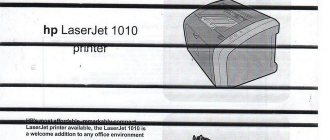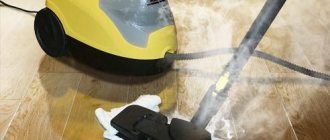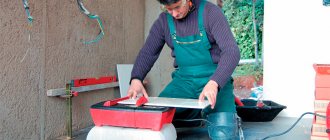Modern construction and repair work cannot be imagined without all kinds of tools and devices that make it possible to reduce effort and time costs. The first levels appeared more than two hundred years ago. Of course, compared to modern analogues, they are very primitive. Especially when compared with a laser level. This new product appeared relatively recently, but has already gained great popularity. But how to use a laser level? What are the nuances and subtleties of such work? In this publication we will look at all these issues in more detail.
Device of laser and optical levels
Levels are a budget type of equipment that is often used by craftsmen. They are quite accurate and reliable when working in different conditions.
The main component of the optical device is a telescope, which magnifies 20 times PHOTO: remoskop.ru
The device is equipped with a cylindrical level for horizontal alignment and an elevation screw for orientation in space. Before use, the level must be mounted on a tripod and leveled using lifting screws. The integrated bubble level will help you determine the correct position. The telescope is aimed at the installed staff using the sighting device and adjusted for sharpness by rotating the eyepiece ring.
Laser products have recently been replacing optical analogues, attracting buyers with their comfort, compact size, simple use and great functionality.
The devices make it possible to take fairly accurate measurements, as well as build straight lines in several planes at the same time. Laser levels are more focused on repair and construction work indoors; household appliances rarely cast a beam with a range of more than 30 m.
Characteristics of Bosch PLL models
The bosch pll 360 laser level has only positive reviews. Most consumers note the particular accuracy of this device, the measurement error of which does not exceed 0.4 mm. The same is said about the operation of a laser diode. The maximum self-leveling limit of the device is 4 degrees, and the laser beam length is 20 meters. The tripod with four threaded divisions supplied in the kit is particularly durable.
Among the shortcomings, some note weak batteries. But at the same time, the device itself is compact in size.
The price of this model on the construction market varies and ranges from 14 thousand rubles, depending on the region.
Experts' opinions on the Bosch PLL 5 model
Laser level Bosch PLL 5
The bosch pll 5 laser level is also characterized only on the positive side.
Many users say that these models are especially easy to set up. The adjustable range of the horizontal line is 360 degrees.
The model is also ergonomic. A convenient tripod and reliable mounts allow you to use the level in any conditions and project diagonal lines from almost any angle.
Reviews from experts about Bosch GLL models
Most consumers also characterize the Bosch Gll models positively. They also have excellent laser diode emission performance.
The quality of work is ensured by the horizontal and vertical projection of the head rotation by 360 degrees. The protection class of “gll” models is higher than that of other analogues, and the device is powered by a high-capacity rechargeable battery.
In addition to a convenient carrying case, the kit includes a target, a tripod and additional fasteners for working in various conditions.
Step-by-step photo instructions for leveling with an optical device
To properly install and configure an optical level, we will need: the level itself, a tripod and a measuring rod.
How to set up a tripod
The main task when installing a tripod is to maintain the correct horizontal base.
| Illustration | Description of action |
| We take out the tripod, fold back the clips, and extend the tripod legs to the height we need. Each of the three legs, thanks to special sliding sliders, extends and is tightly fixed at the required height, and the difference can be either significant or insignificant. We fix the height by clamping the clips. | |
| In order for the tripod to be fixed as rigidly as possible in the ground, we need to press a special footrest with our foot. | |
| We take the level out of the box, place it on a tripod and fix it to the base using a special fastening screw. |
This design allows you to install the level on a tripod evenly, firmly and steadily even on a bumpy surface.
Installation and adjustment of the level
Illustration Description of action
To level the level, we rotate it so that two lifting screws are to the right and left of the device, and the third is located on the front of it.
By rotating the two side screws in opposite directions, we ensure that the air “bubble” is located on the central axis of the level mark.
Now we begin to rotate the screw located on the front of the level and move the air bubble already in the vertical level of the device
When setting up each subsequent bubble level, pay attention to how the previous one behaves.
Setting the device focus
Before you start working with the device, you must correctly focus the optics. Each person adjusts it to their own vision. The stages are as follows:
| Illustration | Description of action |
| We ask your partner to stand with the staff on the first measured point. When taking measurements, the staff must be kept strictly vertical. To do this, we focus on the bubble level that comes with the level. | |
| And now, using the collimator, which is located in the upper part of the level, we aim at it. |
Measuring and recording values
When the device is installed accurately enough, focused and level, you can proceed to measuring data and recording it.
| Illustration | Description of action |
| We adjust the level until we can clearly see the checkers. We look at where the horizontal strip of threads is depicted on the rail. This is our first countdown on the staff. | |
| We record the data. | |
| After this, we measure the next point according to the same principle as the first. We record data and compare indicators. Thus, we know exactly which point is higher and which is lower and by how much. |
Laser equalizers bosch pcl
Laser level Bosch PCL 10
The bosch pcl laser level is characterized by high beam accuracy and a minimum error of 0.5 mm. Most consumers highlight the high self-leveling limits of the device. The bosch pcl model has a fairly wide range of laser beam operation. The device has powerful batteries included with the device. The laser beam diode indicator is 635 nm.
In general, the bosch pcl laser leveler is a compact device that can operate in almost any conditions. It has a built-in cross line feature. In addition, customers note the high speed of automatic plane measurement.
Also in this line of devices, two more models can be noted - bosch pcl 10 and bosch pcl 20. These are two universal devices according to the principle of operation. The first model has a high viewing angle of the laser head - 360 degrees. The ergonomic handle with a soft rubberized insert is very comfortable to use. All produced laser lines are clearly visible even from a great distance thanks to the glass cover of the device.
Bosch PCL 10 laser equalizers are easy to transport and have a protected, waterproof housing. This model has a convenient built-in switch panel with an indicator indicating the readiness of the device for operation, as well as the necessary configuration options.
The Bosch PCL 20 laser level has a number of advantages over other models. First of all, this is the minimum time required to turn on the device, carry out the necessary measurements and the ability to project cross lines.
The equipment comes complete with rechargeable batteries and a case for easy transportation, as well as additional parts for wall mounting. In addition, builders note a convenient tripod, which allows the device to be positioned as firmly as possible on various planes. Manufacturers also took care of installing powerful batteries, so the device can work without interruption for up to 7 hours.
The self-leveling capabilities of the bosch pcl 20 laser level, which are within 4 degrees with a maximum operating range of up to 10 meters, allow you to accurately determine lines on various construction sites. In addition, the laser is highly accurate with a maximum error of 0.5 degrees. In general, all these models are characterized by practicality and are recommended only for interior repairs. Even people who do not have professional skills in working with such tools can handle such devices.
How to work with a laser level: videos and types
There are several types of levels, and each one works a little differently. Static building levels - crossliners or multi-prism builders - are the most common type of device; they are used for small or medium-sized work, and are capable of projecting both intersecting lines and highlighting certain points - a plumb line or zenith.
Rotary line builders – level or multi-prism devices. The principle of operation is that they show both horizontal and vertical planes, so they can indicate lines along the entire perimeter of the room. This is the most expensive device and is used for large-scale construction as well as landscaping. Pros – 360-degree projection capability, long beam range, self-leveling function, low error
There are practically no disadvantages in modern models, the only thing is that you need to work with it carefully, wear special safety glasses and make sure that the beam does not get into the eyes of animals or people
Laser levels may differ in functionality, shape and price
Static axis builders - point lasers or pointers - are the simplest version of the device; it is capable of projecting only one point on any plane; it is most often used for domestic purposes - for wallpapering, placing shelves or paintings. The advantage of this instrument is its high beam range – up to 30 meters. Among the disadvantages - if you need to do a large amount of work and measure many surfaces, then it will need to be constantly turned in the required direction, a high percentage of error is also possible - even a slight deviation can make the parameters incorrect and all markings will be carried out with an error.
Each device must be accompanied by detailed instructions, which indicate the stages of assembling the tool, what is included in its package and how to bring it into working position.
You should also read the safety precautions carefully to avoid an accident.
If the device has a battery, it must be properly and fully charged, and if batteries are installed, it must be installed. Then you need to check the serviceability of the level by turning it on - the appearance of a beam indicates its normal operation.
Experts give a number of tips to help avoid mistakes when working with a laser level:
- There should be no foreign objects on the beam barrier after installation, otherwise the line will be bent.
- The most optimal distance must be used; it is individual for each type of device, so you must follow the attached instructions. If you reduce the distance, the indicator will be more accurate, but to work at a long distance you need to use a special beam receiver, which is included in the kit or purchased separately.
- When working with a level, it must be placed on a flat surface or a tripod. The laser must not oscillate, because then the data will be inaccurate and will need to be reset.
- For precise leveling of the device, some models have a built-in horizontal bubble level with which it is installed, and in more expensive laser levels, a signal is given if it stops, then an accurate check and installation has occurred, it is ready for use.
- When working with the device, it is necessary to warn people and remove animals from the repair site, because the laser beam entering the eyes can cause injury to the retina.
If all recommendations are followed, you can use the device; the data will be accurate and will significantly facilitate all construction work.
Safety first!
For you to see the reflection of a laser on a wall in bright sunlight, the beams must be very powerful. This means that if you are not careful with them and allow people and animals near them, this can seriously affect their health. If the beam gets into your eyes, the consequences can be irreversible! We kindly ask you to remember safety before and during work and use your level carefully. And one more tip: in order to see the rays clearly and clearly and at the same time protect your eyes, wear safety glasses before the upcoming work.
How to check a laser level for accuracy
To be able to unconditionally rely on the readings of the laser level, it must be checked. The technical characteristics of the model indicate the maximum permissible error for this device. It is indicated in mm/m (millimeters per meter)
Naturally, the smaller it is, the better, and this is one of the key parameters that are worth paying attention to. But even when comparing different devices of the same model, you can see a significant difference in readings
For a normal repair result, the deviation should be minimal, and it can be determined by inspection. In theory, this check should be done before purchasing, but few stores will give you this opportunity. Then you can check the laser level at home, and if it does not pass the test, return it or exchange it (don’t lose the receipt). The verification procedure itself is in the video. There are quite a lot of manipulations, but they are not complicated.
What are the characteristics of Bosch laser tools?
First of all, equalizers from this manufacturer are distinguished by the high quality of their components. The self-leveling function of the devices is particularly accurate, and the operating range is at least 20 meters. Most models are additionally equipped with tripods with the function of fixing on any ground. Thanks to this, the equalizers have a distinctively high accuracy, and the measurement error does not exceed 0.4 mm.
The line of laser levels of the German concern has several modifications that are in greatest demand among construction workers. These are models such as bosch pll 360 and bosch pll 5 that deserve special attention.
Leveling and leveling - what is it?
A level is a technical device with which surveyors and builders take measurements of elevation points on a plane. Its main task is to build a stable horizontal line, relative to which any deviations will become noticeable.
Before the invention of the level, level measurements were carried out in this simple way. It is not known for certain what exactly served as containers. One can only guess
If you look into the eyepiece of a modern device, you can see that, in addition to bringing the object closer, the level superimposes a system of thin lines on its image, called a reticle or reticle. This grid creates a pattern on top of the object from vertical and horizontal stripes, which a person is guided by.
It is precisely this picture that a surveyor looks at with such enthusiasm and concentration during measuring work.
Leveling is the process of geodetic surveys using a level. In other words, this is the determination of the difference in heights of two or many points on the earth’s surface relative to a conventional level (for example, ocean level, river level, etc.) or elevation.
An example of using a laser level to mark where handrails are attached to stairs
Laser level models can draw such lines directly on the object. In laser devices, lines are drawn 360° in several planes at once.
Application
To get started, place the level on a tripod or secure it to any stationary surface. This could be a window sill, a chair, a table. Afterwards it is necessary to direct it to the surface that will be leveled or on which something will be installed. The device is turned on and the line is marked with a pencil, then unfold the device and return it to its original position. This checks the accuracy; if the lines match, then the device can be used. Next, all the necessary measurements and laying of marking lines are carried out specifically. After finishing work, be sure to turn off the level.
During operation, under no circumstances should the beam be directed at people or animals, keep children away, and keep it away from moisture. Always turn off the device when carrying it.
How to check the horizon
In order to check the device horizontally, you need to purchase a hydraulic level. We also need two pieces of paper. A hydraulic level is two containers connected to each other by a transparent tube, which has special marks. This is the most inexpensive construction tool that can be bought at any specialty store.
The ideal horizon is set using a hydraulic level in the following way:
- stick two pieces of paper opposite each other on the wall, you can secure it with tape;
- pour water into the device so that it reaches the middle line in each vessel;
- secure the vessel to the first sheet of paper with tape and record the water mark in it;
- with the second flask you need to do the same manipulations, trying to ensure that the water mark is level in the two containers;
- as soon as the level is set, mark the marks on paper;
- Apply the bubble level strictly to the marks; if the bubble is exactly in the middle, the level is good.
Video
This video is about the use of laser devices:
Convenient laser levels, which allow perfectly accurate marking, are readily purchased by both professionals and amateur craftsmen. After all, smooth, bright lines drawn with a laser are clearly visible even at a great distance. But a person without experience may have a question about how to use a laser level correctly. Read about it in this article.
Self-leveling levels
Laser levels of this type are used in professional construction. Most of the equipment is equipped with a tripod for fixing them. On the street, especially during the day and in sunny weather, the LED beam is difficult to see, so special glasses are included in the kit. For uninterrupted operation, the devices are equipped with spare batteries. The self-leveling type of laser levels is divided into three types.
- Pendulum axle builder. It has built-in diodes located on a pendulum that self-levels. This eliminates the need for manual configuration. This is a more complex device that produces up to five beams running in different planes. This functional construction equipment is suitable for leveling walls and other surfaces during the renovation process. The device runs on batteries. In order to save power, the device automatically turns off after a while (about 20 minutes).
- Electronic axis builder. Self-leveling devices of this type are mostly used by professional builders. It is adjusted and aligned vertically by calculations of the electronic equipment system based on slope sensors. These two types belong to line laser levels (static axis builders).
- Rotary axis builder. The most complex and effective, from the point of view of professional construction, is a rotary laser level. The operating principle of a multi-prism level is that the laser emitter is mounted on a rotating electric motor mounted on suspensions. When rotating, the beam is repelled from the prisms, refracting at an angle of 90⁰, which makes it possible to make markings at 360⁰.
There are also point lasers, angles, rulers, and simpler devices for various uses. Video instruction: how to use a laser level.
Getting Started - Pre-Configuration
Level setting
Before starting operation, you must ensure that the device is operating correctly and that the measurements are accurate.
When testing the instrument, the error specified in the passport must match. A small room of about 10 m2 is suitable for testing. Install a stand or tripod, check the reliability and secure the level. Turn on the horizontal line projection so that the beam goes to the corner of the room. On the wall to the right of the device, make a mark of the place where the beam hit, and turn the projection in this direction by 90 degrees.
If, when turning, the laser line coincides with the markings on the wall, then the device is working correctly. If significant errors are visible, you will have to readjust the level.
Auxiliary options for laser levels
Levels are classified into two types: household and professional. Professional ones are also called construction ones, since they are mainly used in construction, electrical installation and geodesy. When carrying out repair work, household laser levels are used, which differ from their professional counterparts not only in price, but also in additional capabilities. As a rule, household levels have a primitive set of functions that allows them to satisfy the needs of the master when carrying out interior finishing repairs. To expand the functionality of the tool, additional equipment is used:
- A laser beam receiver is a special device that allows you to increase the range of the beam (increase its visibility over long distances). This equipment is very convenient when there is a need to use it outdoors. The receiver allows you to observe the projection of the beam not only over long distances, but also in sunlight. The receiver allows you to double the beam distance. When choosing such equipment, you need to take into account that they work clearly in conjunction with only one manufacturer, for example, Bosch. You also need to know that not all models of laser levels can work with receivers. If this is not possible, then you can increase the beam range using a reflective plate
- The target is another additional accessory that comes with many level models. The target is a plate on which markings are applied. Using such an auxiliary device, you can set the accuracy of measurements. An example of using a target is quite simple - instead of an inconspicuous point on the wall, you need to hang this plate, which is much easier and easier to navigate, especially when the distance is 20-30 meters
- The optical sight is another accessory that allows you to track the range of the beam even at a distance of up to 100 meters
- Rail - used in cases where several parallel lines must be drawn on the surface of a wall or other object, while maintaining the same distance. The staff also measures the height of the level attached to the tripod.
All these auxiliary devices make it easier to manipulate the operating device. Professional models of devices have the option of rotating the laser at an angle of 360 degrees. Such devices are especially valuable, since with their help you can make a projection not only on one wall, but throughout the entire room, which simplifies marking work. When all the nuances are known, it is necessary to move on to direct training in using laser levels.
Checking for correct installation
The check is carried out as follows:
- The device is placed between parallel walls, closer to one of the walls (up to 1 meter). The distance to the second one should be more than 2 meters.
- Turn on the level and place two points on both surfaces.
- Move the level directly to the far wall. Align the beam with the point marked on it.
- Project the beam onto the second wall - it should hit the mark.
If the marks match, the device is configured correctly and you can operate. Otherwise, you will need to adjust the tripod and reinstall it.
The greater the distance between the walls during testing, the higher the accuracy of the laser level.
Plane builders
Most of the problems that are solved with the help of a level come down to constructing marks that are on the same horizontal or vertical. Laser plane builders are best suited for this application. Devices of this type produce two or three beams, deployed into sectors located in mutually perpendicular planes.
Most of these devices have scanning angles ranging from 60 to 120, but there are models with circular scanning, 360 in each plane. Light sectors draw vertical and horizontal lines intersecting at right angles on walls, floors, ceilings and other objects. These lines become the basic or working markings, which are needed for construction, repairs, installation of furniture, installation of equipment or communications, for laying tiles, etc.
Beginning of work
Let's not dwell on the need to charge the battery, insert batteries, turn on the device or not forget it at home.
Before starting work, the laser level is installed on a flat, stable platform, or better yet, on a tripod or bracket, which are often included with the device or offered with it.
Most modern models are capable of independently orienting laser markings vertically and horizontally. But only if the body tilt is not too great. Typically the self-leveling range is limited to 4 in each direction. If the inclination is greater, the laser flashes and a beep sounds. This means that the light planes are positioned incorrectly and the device needs to be leveled horizontally.
You can level according to the bubble spirit level, if there is one, or simply until the signal stops. Some models are equipped with tripod stands, the legs of which have screw adjusters. If they are not there, you have to use manual tripod adjustment or improvised means. In any case, the initial installation of the laser level in the working position should not cause significant difficulties.
Using Light Lines
A laser cross drawn with a level on a wall or ceiling can be used in two ways - as reference lines for constructing a working marking or directly as a working marking.
The first method is better if it is not possible to use the device constantly or quickly move it to the desired position. It is also used in cases where it is necessary to create a general “global” markup with a rigid binding of its different elements to each other or to base objects. In this case, the laser lines are duplicated with clearly visible marks, which are used as a basis for further work.
The second method is convenient when laying tiles or other cladding, for orienting and aligning interior parts or design elements that are not closely related to each other. This method is good if the level can be easily installed in any convenient position and just as quickly rearranged when changing places of work. With “floating” markings, the laser level is constantly in operation, so you need to make sure that its battery has sufficient charge.
Using planes
In construction and building repairs, work related to the formation of smooth surfaces is often encountered. For example:
- plastering walls;
- installation of a frame for a partition or false wall;
- gluing drywall to walls;
- laying and leveling the screed.
A flat scan laser is suitable for these tasks. In most cases, the desired plane cannot be lined up directly along the beam. But you can install point beacons, on the tops of which a light line will be displayed. Another way is to use a measuring stick.
An example of using a measuring rod when laying screed.
- Place the level in a position in which it will remain until the end of work.
- Make a measuring stick of a suitable length, convenient for work.
- Place the measuring rod vertically, with the lower end in the position of the designed height of the screed.
- Turn on the level and make a clear mark on the staff where the beam hits.
- Check the height of the screed with a rack: if the mark is above the light line, lower the screed in this place; if below, add the mixture.
Slanted markings
There are many jobs that require orthogonal markings, but not vertical-horizontal, but inclined at an arbitrary angle. These are cases of installation or finishing of staircases, diagonal laying of tiles, marking or finishing along the attic roof.
To obtain an inclined cross, you just need to tilt the level to the desired angle. Before doing this, you need to lock (catch) the auto-leveling system to firmly fix the laser planes and turn off the tilt alarm. Lines are usually aligned to certain objects (stairs) or to existing markings and complement it.
Models with manual settings
The traditional colors of Bosch tools are blue and green. This coloring was chosen for a reason. First of all, it tells the buyer whether the device belongs to the household or professional class.
Models in green cases have manual settings that will need to be done before starting work. As a rule, there is a wheel on the level body for setting the marking angle. There is a certain complexity here - you need to navigate when setting up using additional templates and guides. Things are much simpler with automatic levels that work according to the “plug and forget” rule.
Products with manual adjustment include the Bosch PLL 1 P, Bosch PLT 2 and Bosch PCL 10 Basic. Bosch QUIGO, Bosch GLL 2–50 and most other professional devices mounted in a blue housing have an automatic tuning system.
How rotating laser levels are used in open areas
Such levels are considered one of those that, thanks to the high-speed rotation of the laser head, will project a beam (it will also become noticeable in bright solar radiation).
Laser levels themselves, in combination with optical devices, are often used by specialists on open construction sites PHOTO: profpribor.ru
A characteristic feature of the functioning of such products is that they work perfectly on 360° and point planes. For example, the scanning option will allow you to select only the place where you want to align a door opening or window.
When using this option, the device will display the laser beam only in certain areas PHOTO: profpribor.ru
The level is equally necessary when taking measurements in open spaces, during the construction of large-scale objects, as well as during repair work. If you liked our article, be sure to rate it. In addition, we are always happy to answer your questions, which you can leave in the feedback form.
Watch this video on YouTube
Previous Household appliancesUltrasonic air humidifier: features, selection rules and prices Next Household appliances Do-it-yourself wood milling machine: manufacturing and connection features
How to increase beam range
Laser receiver
We have already talked above about the so-called laser beam receiver, which can be very helpful if you have to carry out work outdoors when the sun is shining brightly.
The laser beam receiver and laser level must be from the same manufacturer. Otherwise, due to model incompatibility, the laser device may unpleasantly surprise you with the absence of visible lines from the beam. If you find yourself in such an unpleasant situation, you can increase the power of the laser beam using a reflective plate. It is enough to attach it to the object being measured and you can get the long-awaited projected lines, although perhaps not so bright.
How to make a laser level with your own hands - step-by-step diagram
Step 1: Upgrade the Pointer
First of all, remove the part of the laser pointer that does not have inserts with pictures. Cover the hole with cardboard and punch a small hole right in the center. Return the cap to its place.
Step 2: Making a support
We use a bar, handle, tripod or tripod as a support. We will sharpen the lower part of the plank and drive it into the ground, and attach plywood, a board, or a sheet of plastic to the upper part strictly at a right angle as a platform.
Step 3: Base for the Bubble Level
We select a bar equal in length to the bubble building level we have, and use a screw to fasten it in the center of our site so that it can be turned in the desired direction.
Step 4: Attach the laser pointer
At the final stage, we need to attach a laser pointer to our bubble level. First, we will place porous rubber under it, this will provide the necessary shock absorption when adjusting the inclination level.
Step 5: Preparing for work
We deepen the support bar into the ground, if we have not done so already. Using a bubble level, we ensure that our new device is strictly horizontal and check these readings from time to time. We turn on the laser pointer and point it at the surface we need. Everything is ready - you can work!
What is the level for?
If anyone doesn’t know, a level is a synonym for a laser level. The material is specifically about a laser level, since there are also optical devices. The tool itself is designed to implement the following tasks:
- Alignment of walls
- Laying tiles and tiles on walls and floors
- Installation of windows and interior doors
- Hang a picture, shelf or furniture on the wall evenly
- Align wall-mounted outlets and switches
The use of a laser level is quite wide, and it is in demand not only among builders and craftsmen. If you plan to renovate a house or apartment, then without such a tool it will be difficult to cover the walls with plasterboard or plaster them evenly. In scientific terms, a level is a device that detects and records the exact location of different objects in height. The main task is to measure the difference in height between the marks of the future structure.
Many experienced builders do not understand why a laser level is needed until they try the tool in action. After all, an alternative option for leveling surfaces, which is used not only by home craftsmen, but also by experienced specialists, is a water level. However, such a tool has large errors and also requires a lot of time to cut a plane on the surface. The level does not have such disadvantages, so it is simply necessary for those who build, repair, lay tiles and lay communications.
This is interesting!
The disadvantage of levels is their high cost; only such financial costs are paid off very quickly, for example, by high-quality and fast repairs or construction of a house.
We're shooting
As a rule, a laser level kit, regardless of model and cost, includes a sighting target - an ordinary plastic plate, which is practically no different from the target that we are used to seeing at the shooting range. What is it for?
Certainly not for entertainment. If, for example, we need to make a hole in the wall a few centimeters lower than on the opposite one, and the distance between these objects is about 50 meters, then this target will help us. Having set it at the required mark, it will not be difficult for us to hit the target with a laser beam and, thus, this problem will be solved. What if the walls are 100 m apart? There's no way to get by with just one target. Imagine that some models of levelers are equipped with an optical sight or sighting device, which will greatly help us at such a “firing” range.
Which laser level is better to choose, do it yourself or buy?
For domestic craftsmen, a level with a laser beam is still a novelty, but in the West it has been successfully used for almost a decade. Since this instrument is a direct descendant of the optical level, it is often called a level, only a laser one. The essence of the device is as follows: a special LED, the same as in a laser pointer or pointer, when combined with mechanical and optoelectronic components, builds planes and directions. From this, the levels are divided into two groups: direction builders and plane builders.
Surely, when you find yourself in front of a rack with a large selection of tools, many of you are wondering: “What is the best level to choose?”, especially if you have never used such equipment before. Laser levels, according to the properties and method of receiving their beam, can be prismatic or positional (the beam appears using a prism, and a line is projected) and rotational (the beam appears from the lens, points are shown).
If you need a relatively inexpensive device, and you will not be involved in the construction of very large objects, then the prism option is quite suitable for you. The most budget option in factory version will cost you about 2.5 thousand rubles, and the rotational level will cost almost 10 times more. But it should be noted that if you are going to use your level a couple of times at most, then it may make sense to try to assemble it yourself. Below we will dwell on this topic in detail.
As experts say, this technique is quite reliable and does not require special skills to operate - just read the instructions carefully. A rotary device is needed by those who will work on a construction site; the beam is capable of “shooting” up to almost 0.5 km. A professional builder or a beginner, before using the tool, will need to set it up using the built-in bubble level or improvised devices. In this regard, we can especially highlight the self-leveling laser level, which will solve this problem without your participation.
Pay attention to the topic of power: some models run only on batteries, others only on batteries. Both options have almost identical pros and cons: the batteries will last for a longer period of time, but you will have to go to the store to get them, the battery will “go out” faster, however, you can handle recharging it yourself at any time
In order to successfully use your new device, you also need the appropriate equipment with a small tripod for mounting on the wall, safety glasses, etc. In general, any such device will not take up much space, but there are also models whose name already states that they are small, but the properties are the same. So the “mini” level has a similar scope to the others and, as the manufacturers write, does not need to be checked, and its certified permissible deviation is about 2 mm per 10 m.
Device setup
The following instructions will help us in this matter. The description is quite detailed, but not always easy to understand. Therefore, it would be better to start with the simplest models. The presence of several bubble levels in the levels will help us make the appropriate adjustments by tightening the screws.
If you take a prism laser level, it can simultaneously emit two lines: horizontal and vertical. If necessary, we can leave only one of them and turn off the other. For example, when checking the verticality of a doorway, we do not need the function of constructing horizontal rays. On some point-type laser devices that emit lines for a plumb line and parallel to a point (nadir, zenith), these modes can also be turned off due to unnecessary use or, conversely, turned on as needed.
In a rotating laser level, there are two more functions: the scanning angle and the speed at which the laser beam rotates. The line is projected, as a rule, in one plane, although there are also models where the vertical axis can be projected at the same time.
How to work with a level
Laser levels can have different sets of functions. In the basic version, it is possible to obtain vertical and horizontal planes, as well as include them together and obtain an intersection. In some models it is possible to obtain a point at the zenith and below the device (plumb, point - nadir), there is also a function of constructing two parallel vertical planes. Additional features are useful, but their presence increases the cost as the system becomes more complex. Some manufacturers add tripods or platforms to the basic package that can be mounted on the wall with a screw or magnet.
The main functions of a household-grade level (plane builder)
The models also differ in the possible angle of the plane aligned in the horizontal surface (sweep angle). It can be from 110° to 360°. The easiest way to work is with the one that gives a complete plane, but it is a professional model and costs a lot. You can get a complete plane even with a small plane of luminescence. To do this, the device is rotated around its axis.
When using the device outdoors, the laser catcher may be useful. It is usually purchased separately. When purchasing, you need to check whether this model is compatible with your laser. Special glasses may be helpful. Firstly, they protect the eyes from accidental exposure to the laser, and secondly, they allow you to see the beam more clearly.
Use when working on the floor
It is convenient to use a laser level when leveling the floor. Place it approximately in the middle of the room and turn on the construction of a horizontal plane. A straight line is marked on the walls, along which it is convenient to make markings.
The horizontal plane is displayed on the walls
The laser beam is also displayed on any object that you place in its path. Using this property and a ruler (tape measure), you can find the most protruding and most “recessed” part of the floor. Using this data, you will determine at what minimum level you can screed the floor. Next, based on the found height, make marks on the walls and begin installing the beacons. They can also be placed along the beam. Having set the laser beam to the desired height, set the back of the lighthouse so that it is evenly illuminated by it.
Using the same horizontal surface, you can check how evenly the concrete is laid in the screed. The beam will be visible on the hillocks, and the depressions can be found using a rod.
How to use a laser level to lay floor tiles
You can also use a laser level when laying tiles on the floor. To do this, you need to get the intersection of the rays on the floor. Set the required mode, choose the direction in which you will lay the tiles and, along the line visible on the floor, align the seam.
What can it do on the walls?
Now let's look at how to use a laser level on walls even more actively:
- Check how crooked the wall is. Parallel to it, at a distance of several centimeters, beat off a horizontal plane with a laser. Using a ruler or tape measure, measure the distance from the beam to several points on the wall. This determines how littered the wall is and in what place you can find recesses and bumps. This procedure is necessary when leveling walls.
- Using the same technique, you can check the verticality of the corners.
- Mark a horizontal line for fastening something: furniture, a profile for a gypsum board ceiling, etc.
- Get a crosshair for laying tiles on the wall.
- Have a vertical line to properly apply the first sheet of wallpaper. horizontal to evenly stick a border, etc.
- Check the vertical slopes of windows or doors.
- Mark the line for wiring.
You often have to use a laser level during repairs, and later in everyday life, for small jobs you often need it: to hang something straight, to set up household appliances (a washing machine, for example), etc.
Measuring rod
Measuring rod Bosch GR 500
The need for it arises when you need to mark two or more lines on an object, located parallel to each other and with the same distance between them. The rail also serves to allow you to change the height of the laser device, which at this moment is located on a tripod.
Perhaps, in order to understand how to use a laser level correctly, we need to talk more specifically about how to use it in practice. For example, we decided to put laminate flooring in the room. This requires a perfectly flat surface. How can a laser level help solve this problem?
- We install the device on the floor, fixing it on a tripod.
- Using the built-in bubble levels, we level the level.
- We turn on the laser device and mark perfectly projected horizontal lines on a vertical plane with a tapping cord soaked in dry blue.
- We unfold the device and project the lines onto other walls of the room, repeating the same steps. It is worth saying that in this case it is very convenient to work with rotational models, since they do not need to be rotated every time. When working, they project a projection onto all walls of the room at once. This is how a laser level will serve you well for leveling the floor.
As for rotary models, it is especially worth highlighting laser levels from Bosch.
Bosch laser level
They are distinguished by high accuracy and performance, even in unfavorable conditions: with high air humidity or dust. This allows the device to be used outdoors without worrying that its performance may suffer. With the help of nitrogen, the optical system of the Bosch level is well protected, so it is not afraid of condensation. It can be successfully used at temperatures from -20 to +50 º C.











